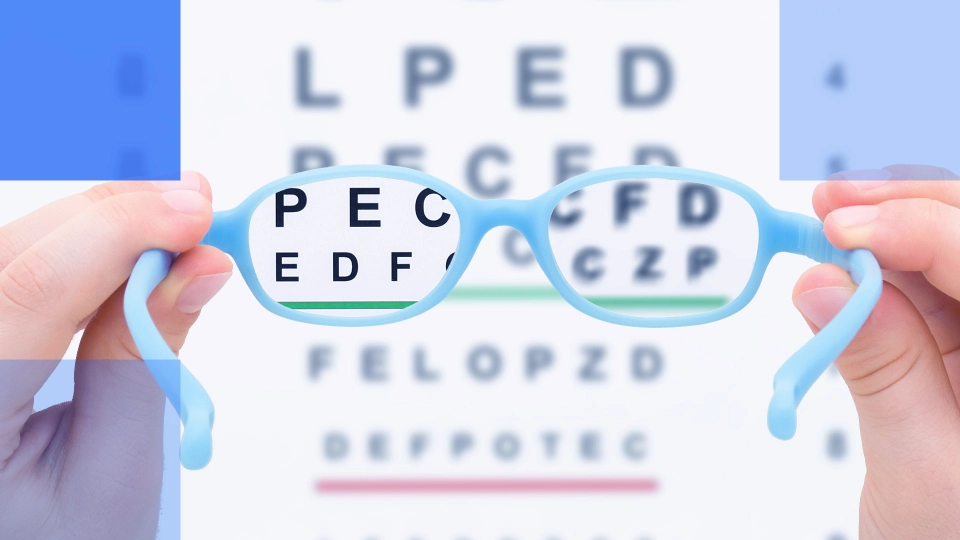A New Algorithm for Identifying Saccadic Movements in Eye-Tracking Studies
- Why saccade tracking matters in progressive lenses
- How the study was conducted
- Participants and study design
- How the new algorithm improves saccade tracking
- Key findings: How PPL design affects saccadic movements
- Distance reading task
- Near reading task
- Implications for optical labs and ECPs
- For optical labs
- For ECPs
- Advancing eye-tracking analysis in lens research
- Download the Full Poster
A New Algorithm for Identifying Saccadic Movements in Eye-Tracking Studies
Saccades—rapid, coordinated eye movements—play a crucial role in vision, especially for wearers of progressive power lenses (PPLs). These lenses allow users to transition between different focal zones, but how effectively they do so depends on how the eyes move. However, traditional methods for tracking saccades often struggle with accuracy, particularly in real-world conditions using wearable eye-tracking devices. This limitation can lead to incomplete insights into lens performance and wearer experience.
A new algorithm aims to improve saccade detection and analysis, addressing these gaps. By comparing this approach to the widely used Tobii I-VT fixation filter, researchers evaluated how different PPL designs influence saccade characteristics during distance and near reading tasks. These findings have important implications for optical labs and eye care professionals (ECPs) looking to optimize progressive lens design and improve wearer adaptation.

Figure 1. Gaze samples with a velocity below the threshold corresponds to fixations (blue) and above to saccades (green).
Why saccade tracking matters in progressive lenses
Progressive lenses are designed to provide smooth vision at all distances, but wearers don’t always use them as intended. Factors like peripheral distortions, adaptation challenges, and individual viewing habits can all impact gaze shifts and visual comfort. Analyzing saccadic movements offers valuable insights that can:
- Improve lens designs to enhance comfort and adaptation
- Help eye care professionals (ECPs) guide patients toward the right lens choice
- Reduce wearer discomfort caused by inefficient visual transitions
However, traditional velocity-based algorithms often misclassify saccades in wearable eye-tracking data due to lower sampling rates and fragmented movements. This study introduces a new method to improve classification and analysis, providing a more reliable way to track real-world eye movements.

Figure 2. Cylinder power distribution maps of the PPLs tested in this study.
How the study was conducted
Participants and study design
This double-masked, longitudinal study included 28 PPL wearers (17 men, 11 women) aged 46 to 64. All participants had normal vision and no conditions affecting their eye movements.Each subject was fitted with three different free-form PPL designs:
- PPL-Distance (PPL-D) – optimized for a wider distance vision area
- PPL-Near (PPL-N) – designed for a larger near-vision zone
- PPL-Balance (PPL-B) – a symmetrical distribution for general use
Eye movements were recorded using Tobii Pro Glasses 3 while participants performed distance and near reading tasks. The collected data was processed using both the existing Tobii I-VT fixation filter and the newly developed algorithm.

Figure 3. Scheme for the evaluation of reading speed at distance vision (A) and near vision (B).
How the new algorithm improves saccade tracking
The new algorithm addresses key weaknesses in traditional velocity-based tracking by:
- Maintaining reliable fixation classification from the original Tobii I-VT filter
- Reclassifying fragmented movements between fixations as single saccades
- Refining saccade duration calculations by summing all gaze data between fixations
- Improving saccade amplitude measurements for greater accuracy
- Filtering out noise and misclassifications using an outlier detection algorithm
By correcting misclassifications and integrating fragmented movements, this method provides a clearer picture of how wearers interact with different lens zones, particularly in lower-sampling wearable eye-tracking systems.

Figure 4. Saccade amplitude (θ) calculation from one fixation (Fn) to the next (Fn+1).
Key findings: How PPL design affects saccadic movements

Figure 5. Example of gaze data where saccade is divided into several parts using the original algorithm (A), and when applying the new algorithm than unifies the saccade and data loss into a single movement (B).
Distance reading task
With the new algorithm, the number of saccades better aligned with the number of fixations, showing one fewer saccade than fixations per trial. Compared to the original algorithm:
- Saccade count decreased by 26% in PPL-D, 26% in PPL-B, and 25% in PPL-N
- Saccade time increased by 22% in PPL-D, 24% in PPL-B, and 21% in PPL-N
- Significant differences were found in saccade count (p=0.04) and amplitude (p=0.04) between designs
- PPL-D showed fewer saccades and greater saccade amplitude compared to PPL-N
Near reading task
Similar trends were observed in near reading:
- Saccade count decreased by 33% in PPL-N, 34% in PPL-B, and 36% in PPL-D
- Saccade time increased by 32% in PPL-N, 34% in PPL-B, and 41% in PPL-D
- Significant differences were found in saccade count (p<0.001), saccade time (p<0.001), and saccade amplitude (p=0.002)
- PPL-N showed the lowest saccade count and saccade time, but the highest saccade amplitude
These findings suggest that PPL-D is more efficient for distance vision tasks, while PPL-N facilitates smoother near reading movements, influencing wearer comfort and adaptation.

Figure 6. Mean values and 95% confidence intervals for fixation and saccade count (A), saccade time (B), and mean saccade amplitude (C) for each of the PPL designs. Denotes statistically significant differences between PPL groups.
Implications for optical labs and ECPs
For optical labs
- Improve progressive lens designs by considering how power distribution affects saccades
- Optimize lens transitions to enhance comfort and reduce adaptation time
- Develop better quality control methods for assessing real-world lens performance
For ECPs
- Offer better lens recommendations based on patients’ visual habits
- Help patients adapt to new prescriptions by understanding their natural eye movement patterns
- Educate wearers on lens selection for tasks like reading, computer use, or driving
Advancing eye-tracking analysis in lens research
This study introduces an improved algorithm for detecting and classifying saccadic movements in wearable eye-tracking data. By refining gaze data analysis, researchers provide new insights into how different PPL designs influence eye movements in both distance and near vision tasks.
These findings can help optimize progressive lens performance, improve wearer comfort, and support ECPs in making more informed lens recommendations.
Download the Full Poster
Explore the development of a new algorithm for more accurate saccade detection using wearable eye-tracking. This poster outlines the study’s methodology, comparison to traditional tracking methods, and key findings on how different progressive lens designs influence eye movements. Learn how these insights can support better lens design, wearer adaptation, and real-world performance analysis.






